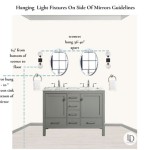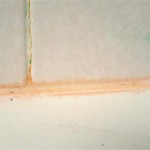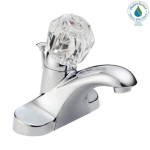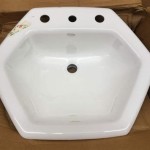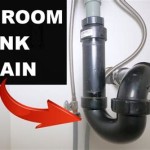Bathroom Sink Drain Filters: Preventing Clogs and Maintaining Plumbing Health
The bathroom sink is a frequently used fixture, subjected to a variety of materials that can potentially cause drain clogs. Hair, soap scum, toothpaste, and small debris are common culprits that accumulate over time, reducing water flow and eventually leading to complete blockages. A bathroom sink drain filter provides a simple yet effective solution for mitigating these issues, preserving the functionality and longevity of plumbing systems.
A drain filter, also referred to as a drain strainer or mesh, is a device designed to capture solid particles before they enter the drainpipe. It acts as a physical barrier, preventing unwanted materials from flowing into the plumbing system where they can contribute to clogs. These filters are typically made from durable, corrosion-resistant materials such as stainless steel, plastic, or silicone, ensuring longevity and consistent performance even with regular use.
The installation of a bathroom sink drain filter is generally straightforward and requires minimal tools or expertise. Most filters are designed to fit snugly within the drain opening, held in place by friction or a simple locking mechanism. This ease of installation makes them accessible to homeowners of all skill levels, offering a proactive approach to plumbing maintenance.
Regular cleaning of the drain filter is essential for maintaining its effectiveness. Accumulated debris should be removed periodically, typically every few days or weeks depending on usage. This cleaning process is usually a simple matter of removing the filter, rinsing it under running water, and replacing it in the drain. Neglecting to clean the filter can lead to the same problems it is designed to prevent, as a full filter can impede water flow and allow debris to bypass it entirely.
Key Benefits of Using a Bathroom Sink Drain Filter
Implementing a bathroom sink drain filter offers numerous advantages, primarily related to preventing clogs and minimizing the need for costly plumbing repairs. The initial investment in a drain filter is relatively low, while the potential savings in terms of avoiding plumbing services can be significant.
One of the primary benefits is the prevention of drain clogs. By capturing hair, soap scum, and other debris, the filter prevents these materials from accumulating in the drainpipe. This proactive approach reduces the frequency of slow drains and complete blockages, maintaining optimal water flow and preventing the inconvenience of dealing with backed-up sinks.
Another significant advantage is the reduction in the need for harsh chemical drain cleaners. These chemicals, while effective at dissolving clogs, can be corrosive and damaging to pipes over time. By preventing clogs in the first place, drain filters minimize or eliminate the need for such aggressive cleaning agents, extending the lifespan of the plumbing system.
Furthermore, drain filters can help protect the environment. By preventing hair and other debris from entering the wastewater system, they reduce the burden on wastewater treatment plants. This contributes to a more sustainable approach to water management and reduces the potential for environmental pollution.
Reduced plumbing maintenance costs also represent a notable benefit. Frequent clogs can necessitate professional plumbing services, which can be expensive. By preventing clogs, drain filters reduce the likelihood of needing to call a plumber, resulting in long-term cost savings for homeowners.
Types of Bathroom Sink Drain Filters
Various types of bathroom sink drain filters are available, each with unique features and benefits. The choice of filter depends on individual needs, preferences, and the specific design of the sink drain.
One common type is the standard mesh filter, typically made of stainless steel or plastic. These filters feature a fine mesh that effectively captures hair and other small debris. They are usually inexpensive and readily available at most hardware stores and online retailers. The simplicity of their design makes them easy to install and clean.
Another variety is the pop-up drain filter, which replaces the existing pop-up drain stopper. These filters feature a perforated design that allows water to flow through while capturing debris. They often include a basket or cage beneath the perforated surface to collect the debris, making cleaning easier. These filters offer a more seamless and integrated appearance compared to standard mesh filters.
Silicone drain filters represent another option, often featuring a mushroom-shaped design with flexible silicone bristles. These bristles allow water to pass through while trapping hair and other debris. Silicone filters are known for their durability and ease of cleaning, as the flexible material makes it easy to dislodge trapped debris. They are also resistant to corrosion and mold growth.
Universal drain filters are designed to fit a wide range of drain sizes and configurations. These filters typically feature adjustable components that allow them to be customized to fit specific sink drains. They are a good option for homeowners who are unsure of their drain size or who want a filter that can be easily transferred between different sinks.
When selecting a drain filter, it is important to consider the material, design, and ease of cleaning. Stainless steel filters are durable and corrosion-resistant, while plastic filters are lightweight and inexpensive. The design of the filter should effectively capture debris while allowing for adequate water flow. Ease of cleaning is also a crucial factor, as regular cleaning is necessary to maintain the filter's effectiveness.
Proper Installation and Maintenance of Drain Filters
Proper installation and maintenance are essential for ensuring the effectiveness and longevity of bathroom sink drain filters. While installation is typically straightforward, following the manufacturer's instructions is crucial to ensure a secure and proper fit. Regular cleaning is equally important for preventing clogs and maintaining optimal water flow.
Before installing a drain filter, it is important to ensure that the drain opening is clean and free of any debris. This will ensure a proper fit and prevent the filter from becoming clogged prematurely. If necessary, the drain can be cleaned with a brush or a mild cleaning solution.
When installing a standard mesh filter, simply place it into the drain opening, ensuring that it sits flush with the sink surface. Some filters may have a locking mechanism that needs to be engaged to secure the filter in place. For pop-up drain filters, the existing pop-up drain stopper needs to be removed and replaced with the new filter. Follow the manufacturer's instructions for proper alignment and tightening of the filter.
Regular cleaning is crucial for maintaining the effectiveness of the drain filter. Depending on usage, the filter should be cleaned every few days or weeks. To clean the filter, simply remove it from the drain opening and rinse it under running water. Use a brush or sponge to remove any stubborn debris. For silicone filters, the flexible bristles can be easily cleaned by flexing the material.
Avoid using harsh chemicals or abrasive cleaners to clean the drain filter, as these can damage the material. A mild soap and water solution is typically sufficient for removing most debris. If the filter is heavily soiled, it can be soaked in a solution of vinegar and water for a few hours to loosen the debris before rinsing.
Inspect the drain filter regularly for any signs of damage or wear. If the filter is cracked, broken, or corroded, it should be replaced immediately. A damaged filter will not effectively capture debris and may even contribute to clogs.
In addition to regular cleaning of the drain filter, it is also advisable to periodically flush the drainpipe with hot water to remove any accumulated soap scum or other residue. This can help prevent clogs from forming deeper within the plumbing system. Pouring a cup of baking soda followed by a cup of vinegar down the drain, and then flushing with hot water after 30 minutes, can also help to dissolve minor clogs and keep the drain clean.
By following these simple installation and maintenance tips, homeowners can ensure that their bathroom sink drain filters provide effective protection against clogs and contribute to the long-term health of their plumbing systems. This proactive approach can save time, money, and the inconvenience of dealing with blocked drains.

Universal Sink Drain Filter Stainless Steel Bounce Core Push Type Converter Bathroom Drainer Pipe Fittings Wish

Bathroom Sink Drain Stainless Steel Pop Up Bounce Core Basin Filter Hair Catcher Shower Strainer Bath Stopper Tools Temu Denmark

Universal Wash Basin Core Bounce Drain Filter Pop Up Bathroom Sink Plug Stopper

Kitchen Bathroom Sink Drain Strainer Screen Stopper Metal Filter Basket 9cm Dia Com

Wash Basin Bounce Drain Filter Up Copper Core Bathroom Sink Plug With Anti Clogging Basket Stopper Accessories Temu

Basin Pop Up Drain Filter Sink Plug For 1 34 45 Holes Bathroom With Basket 1pcs Com

Universal Pop Up Sink Drain Stopper Anti Clog Filter Bathroom Bathtub For Kitchen 38 41mm Holes

Bathroom Sink Plug Pop Up Drain Filter Bath Fruugo No

Universal Wash Basin Core Bounce Drain Filter Pop Up Bathroom Sink Plug Stopper

Kitchen Bathroom Sink Drain Plug Bathtub Filter Screen Silicone Floor Wish
Related Posts
